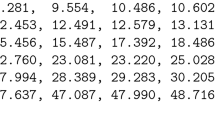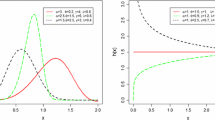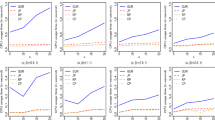Abstract
In this paper, we discuss the existence and uniqueness of the maximum likelihood estimates (MLEs) of the parameters of Laplace Birnbaum–Saunders distribution based on Type-I, Type-II and hybrid censored samples. We first derive the relationship between the MLEs of the two parameters and then discuss the monotonicity property of the profile likelihood function. Numerical iterative procedure is then discussed for determining the MLEs of the parameters. Finally, for illustrative purpose, we analyze one real data from the literature and present some graphical illustrations of the approach.



Similar content being viewed by others
References
Arnold BC, Balakrishnan N, Nagaraja HN (1992) A first course in order statistics. Wiley, New York
Balakrishnan N (2007) Progressive censoring methodology: an appraisal (with discussions). Test 16:211–296
Balakrishnan N, Aggarwala R (2000) Progressive censoring: theory, methods, and applications. Birkhäuser, Boston
Balakrishnan N, Cohen AC (1991) Order statistics and inference: estimation methods. Academic Press, San Diego
Balakrishnan N, Cramer E (2014) The art of progressive censoring: applications to reliability and quality. Birkhäuser, Boston
Balakrishnan N, Cutler CD (1996) Maximum likelihood estimation of Laplace parameters based on Type-II censored samples. In: Morrison DF, Nagaraja HN, Sen PK (eds) Statistical theory and applications: papers in honor of Herbert A. David. Springer, Berlin, pp 145–151
Balakrishnan N, Kundu D (2013) Hybrid censoring: models, inferential results and applications (with discussions). Comput Stat Data Anal 57:166–209
Balakrishnan N, Leiva V, Lopez J (2007) Acceptance sampling plans from truncated life tests based on the generalized Birnbaum–Saunders distribution. Commun Stat Simul Comput 36:643–656
Balakrishnan N, Zhu X (2014) On the existence and uniqueness of the maximum likelihood estimates of the parameters of Birnbaum–Saunders distribution based on Type-I, Type-II and hybrid censored samples. Statistics 48:1013–1032
Barreto LS, Cysneiros AHMA, Cribari-Neto F (2013) Improved Birnbaum–Saunders inference under type II censoring. Comput Stat Data Anal 57:68–81
Barros M, Paula GA, Leiva V (2009) An R implementation for generalized Birnbaum–Saunders distributions. Comput Stat Data Anal 53:1511–1528
Birnbaum ZW, Saunders SC (1969) A new family of life distributions. J Appl Probab 6:319–327
Birnbaum ZW, Saunders SC (1969) Estimation for a family of life distributions with applications to fatigue. J Appl Probab 6:327–347
Bryson MC, Siddiqui MM (1969) Some criteria for aging. J Am Stat Assoc 64:1472–1483
Childs A, Chandrasekar B, Balakrishnan N, Kundu D (2003) Exact likelihood inference based on Type-I and Type-II hybrid censored samples from exponential distribution. Ann Inst Stat Math 55:319–330
Diáz-García JA, Leiva-Sánchez V (2005) A new family of life distributions based on the elliptically contoured distributions. J Stat Plan Inference 128:445–457 (Erratum, 137:1512–1513)
Epstein B (1954) Truncated life-test in exponential case. Ann Inst Stat Math 25:555–564
Kotz S, Kozubowski TJ, Podgórski K (2001) The Laplace distribution and generalizations: a revisit with applications to communications, economics, engineering, and finance. Birkhäuser, Boston
Leiva V, Riquelme M, Balakrishnan N (2008) Lifetime analysis based on the generalized Birnbaum–Saunders distribution. Comput Stat Data Anal 21:2079–2097
Lemonte AJ, Ferrari SL (2011) Testing hypotheses in the Birnbaum–Saunders distribution under Type-II censored samples. Comput Stat Data Anal 55:2388–2399
Ng HKT, Kundu D, Balakrishnan N (2003) Modified moment estimation for the two-parameter Birnbaum–Saunders distribution. Comput Stat Data Anal 43:283–298
Ng HKT, Kundu D, Balakrishnan N (2006) Point and interval estimation for the two-parameter Birnbaum–Saunders distribution based on Type-II censored samples. Comput Stat Data Anal 50:3222–3242
Sanhueza A, Leiva V, Balakrishnan N (2008) The generalized Birnbaum–Saunders distribution and its theory, methodology, and application. Commun Stat Theory Methods 37:645–670
Zhu X, Balakrishnan N (2015) Birnbaum–Saunders distribution based on Laplace kernel and some properties and inferential issues. Stat Probab Lett 101:1–10
Acknowledgements
We express our sincere thanks to the anonymous reviewers for their useful comments and suggestion on an earlier version of this manuscript which led to this improved version.
Funding
This research was supported by the National Natural Science Foundation of China—Young Scientists Fund [No. 11801459], Jiangsu Science and Technology Programme—The Young-Scholar Programme [No. BK20180241] and the Research Development Fund of Xian-Jiaotong Liverpool University [No. RDF-17-01-20]. The second author thanks the Natural Sciences and Engineering Research Council of Canada for supporting this research.
Author information
Authors and Affiliations
Corresponding author
Additional information
Publisher's Note
Springer Nature remains neutral with regard to jurisdictional claims in published maps and institutional affiliations.
Appendix
Appendix
Proof of Remark 1
It is clear that \(\alpha (\beta ,t_{k:n},k)\) in (12), for \(\beta \le t_{k:n}\), is not differentiable at \(\beta =t_{i:n}\), for \(i=1,\ldots ,k\). However, it is continuous, and so we can consider \(\alpha (\beta ,t_{k:n},k)\) reaches the local maximum or local minimum at t if \(\lim \nolimits _{x\rightarrow t^+} \alpha '(x,t_{k:n},k)\lim \nolimits _{x\rightarrow t^-}\alpha '(x,t_{k:n},k)<0\). For the sake of convenience, we define \(\alpha '(x,t_{k:n},k)=0\) if \(\lim \nolimits _{x\rightarrow t^+} \alpha '(x,t_{k:n},k)\lim \nolimits _{x\rightarrow t^-}\alpha '(x,t_{k:n},k)<0\). Now, if \(t_{j:n}<\beta <t_{j+1:n}\), \(j=0,\ldots ,k-1,\) with \(t_{0:n}\equiv 0\), then the first derivative of \(\alpha \) with respect to \(\beta \) is given by
It is clear that when \(\beta \rightarrow 0\), we have \(j=0\) and so
We also have
and
which suggests that there exists at most one root for \([\beta \alpha '(\beta ,t_{k:n},k)]=0\), thus showing that there exists at most one root for \(\alpha '(\beta ,t_{k:n},k)=0\) in turn. We can thus conclude the lemma, as required. \(\square \)
Proof of Lemma 1
Let us consider the first derivative of \(\ln L_{profile}\) with respect to \(\beta \) in each interval \((t_{j:n} , t_{j+1:n})\), for \(j=0,\ldots , k-1\), with \(t_0\equiv 0\), given by
where \(\gamma (\beta )=-\beta ^2 k\alpha '(\beta ,t_{k:n},k)+\beta \alpha (\beta ,t_{k:n},k)\sum \nolimits _{i=1}^k\frac{\beta -t_{i:n}}{2(\beta +t_{i:n})}\).
Moreover, we have
Thus, if \(\lim _{\beta \rightarrow t_{k:n}^-}\ln L'_{pro}<0\), then there must exist a \(\beta _0\) such that \(\gamma (\beta )>0\) for \(\beta <\beta _0\) and \(\gamma (\beta )<0\) for \(\beta >\beta _0\). We show in the following once \(\gamma (\beta )<0\), then \(\gamma (\beta )\) will be a decreasing function of \(\beta \), which in turn suggests that there will be no root for \(\gamma (\beta )=0\) for \(\beta >\beta _0\). The first derivative of \(\gamma (\beta )\) is
Moreover, for any non-differentiable point \(t_{j:n}\) for \(j=1,\ldots ,k-1\), we have
We can thus conclude that if \(\lim \nolimits _{\beta \rightarrow t_{k:n}}\ln L'_{pro}<0\), then there exists only one root for the equation \(\ln L'_{pro}(\beta )=0\) for \(\beta \le t_{k:n}\), and if \(\lim \nolimits _{\beta \rightarrow t_{k:n}}\ln L'_{pro}>0\), then there will be no root for the equation \(\ln L'_{pro}(\beta )=0\) for \(\beta \le t_{k:n}\). \(\square \)
Proof of Lemma 3
We will first prove that \(H(\eta (\beta ,t_{k:n}))\) is a decreasing function of \(\beta \) for \(\beta >t_{k:n}\). It is well-known that the hazard function of the standard Laplace distribution is an increasing function of x for \(x<0\) and a constant for \(x\ge 0\). Studying the monotonicity of \(H(\eta (\beta ,t_{k:n}))\) is equivalent to studying the property of \(\eta (\beta ,t_{k:n})\), where
Let us denote \(g_1(\beta )=\left( \sqrt{\frac{\beta ^2}{t_{k:n}}}-\sqrt{t_{k:n}}\right) \left( {\sum \limits _{i=1}^k\frac{t_{k:n}+t_{i:n}}{t_{i:n}+\beta }}\right) \); we then have
Hence, \(\eta (\beta ,t_{k:n})\) is a decreasing function of \(\beta \).
Next, we will prove that \(\alpha (\beta ,t_{k:n},k)\sqrt{\beta }\sum \nolimits _{i=1}^k\frac{t_{i:n}}{t_{i:n}+\beta }=g_2(\beta )\) is an increasing function of \(\beta \) for \(\beta >t_{k:n}\), where
Let us consider
then, we have
showing the monotonicity of \(g_2(\beta )\) and then \(G(\beta )\) in turn.
Moreover, we have
\(\square \)
Rights and permissions
About this article
Cite this article
Zhu, X., Balakrishnan, N. & Saulo, H. On the existence and uniqueness of the maximum likelihood estimates of parameters of Laplace Birnbaum–Saunders distribution based on Type-I, Type-II and hybrid censored samples. Metrika 82, 759–778 (2019). https://doi.org/10.1007/s00184-019-00707-8
Received:
Published:
Issue Date:
DOI: https://doi.org/10.1007/s00184-019-00707-8
Keywords
- Birnbaum–Saunders distribution
- Existence
- Generalized Birnbaum–Saunders distribution
- Hybrid censoring
- Laplace Birnbaum–Saunders distribution
- Maximum likelihood estimate
- Type-I censoring
- Type-II censoring
- Uniqueness




